Nursing Ethics and Legal Issues: Analysis of Dilemmas and Restraints
VerifiedAdded on 2023/01/11
|6
|1312
|20
Report
AI Summary
This report analyzes ethical dilemmas encountered by nurses in various scenarios, referencing the NMC guidelines. The report examines cases involving student nurses, patient safety, and the disclosure of sensitive information. It also explores the ethical and legal implications of restraints, particularly for patients with dementia, considering patient rights and safety. The analysis emphasizes the importance of ethical decision-making, adherence to legal standards, and the protection of patient well-being, providing insights into best practices for nurses. The report also emphasizes the importance of following NMC guidelines to ensure patient safety and ethical conduct in challenging situations. The report provides a detailed overview of ethical dilemmas faced by nurses and legal considerations, providing valuable insights for students of nursing.
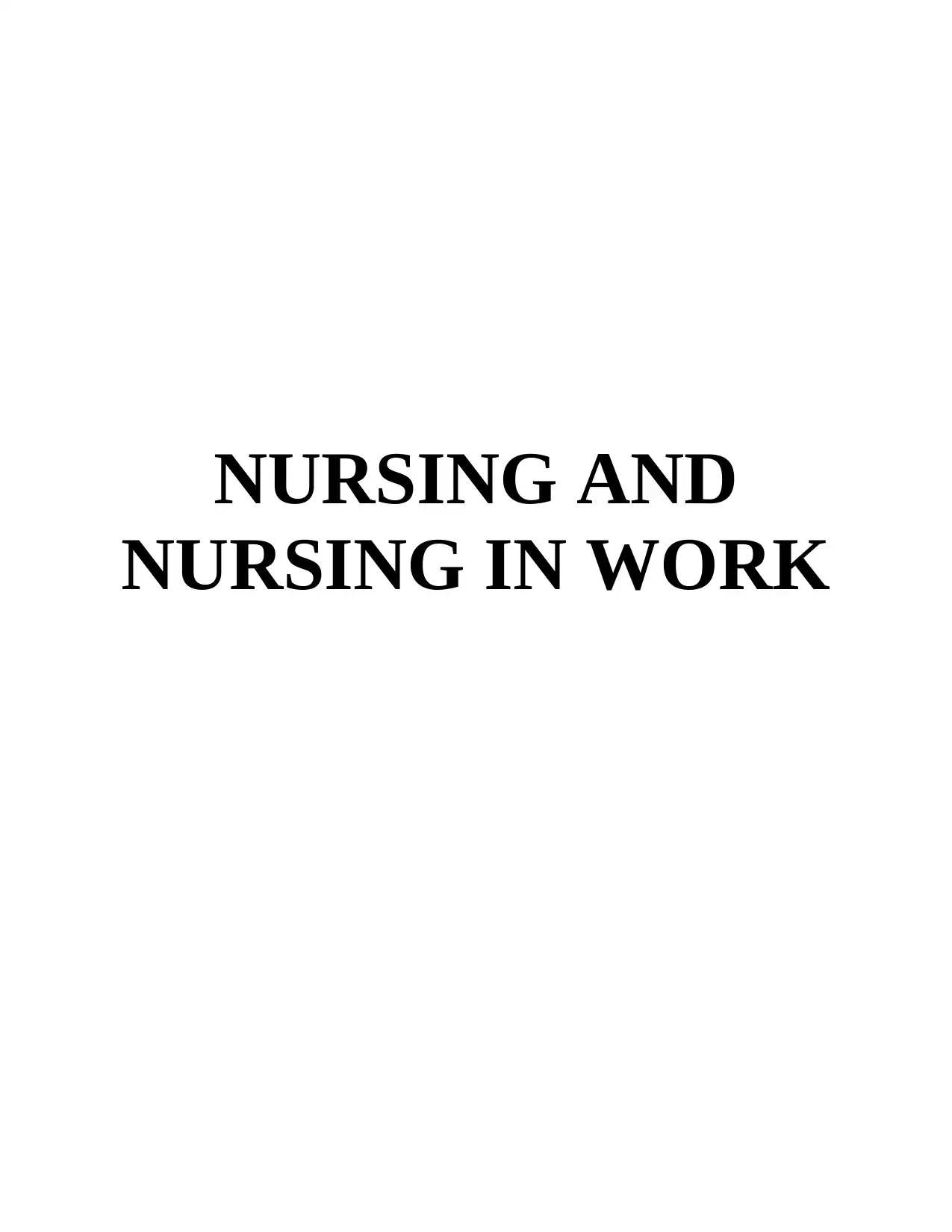
NURSING AND
NURSING IN WORK
NURSING IN WORK
Paraphrase This Document
Need a fresh take? Get an instant paraphrase of this document with our AI Paraphraser
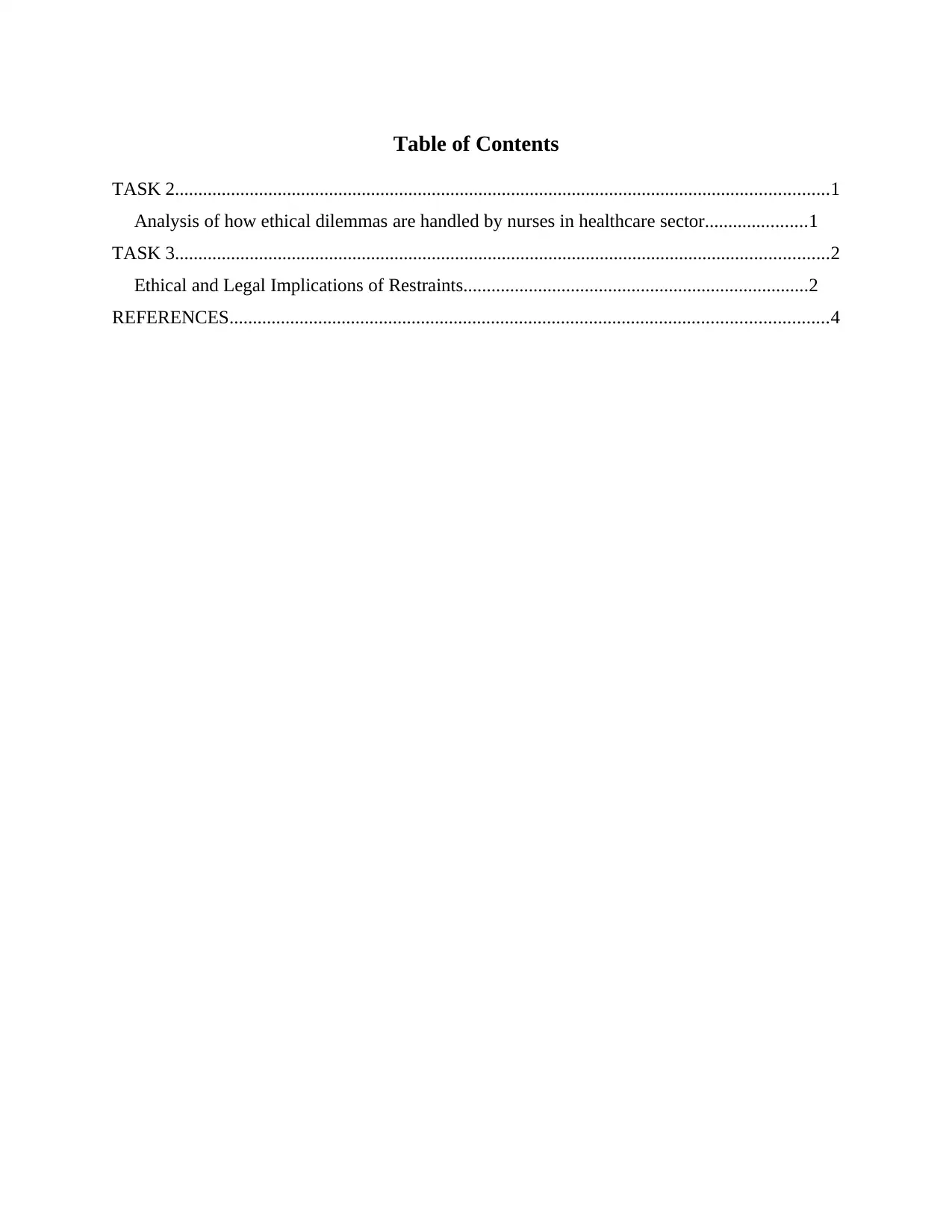
Table of Contents
TASK 2............................................................................................................................................1
Analysis of how ethical dilemmas are handled by nurses in healthcare sector......................1
TASK 3............................................................................................................................................2
Ethical and Legal Implications of Restraints..........................................................................2
REFERENCES................................................................................................................................4
TASK 2............................................................................................................................................1
Analysis of how ethical dilemmas are handled by nurses in healthcare sector......................1
TASK 3............................................................................................................................................2
Ethical and Legal Implications of Restraints..........................................................................2
REFERENCES................................................................................................................................4
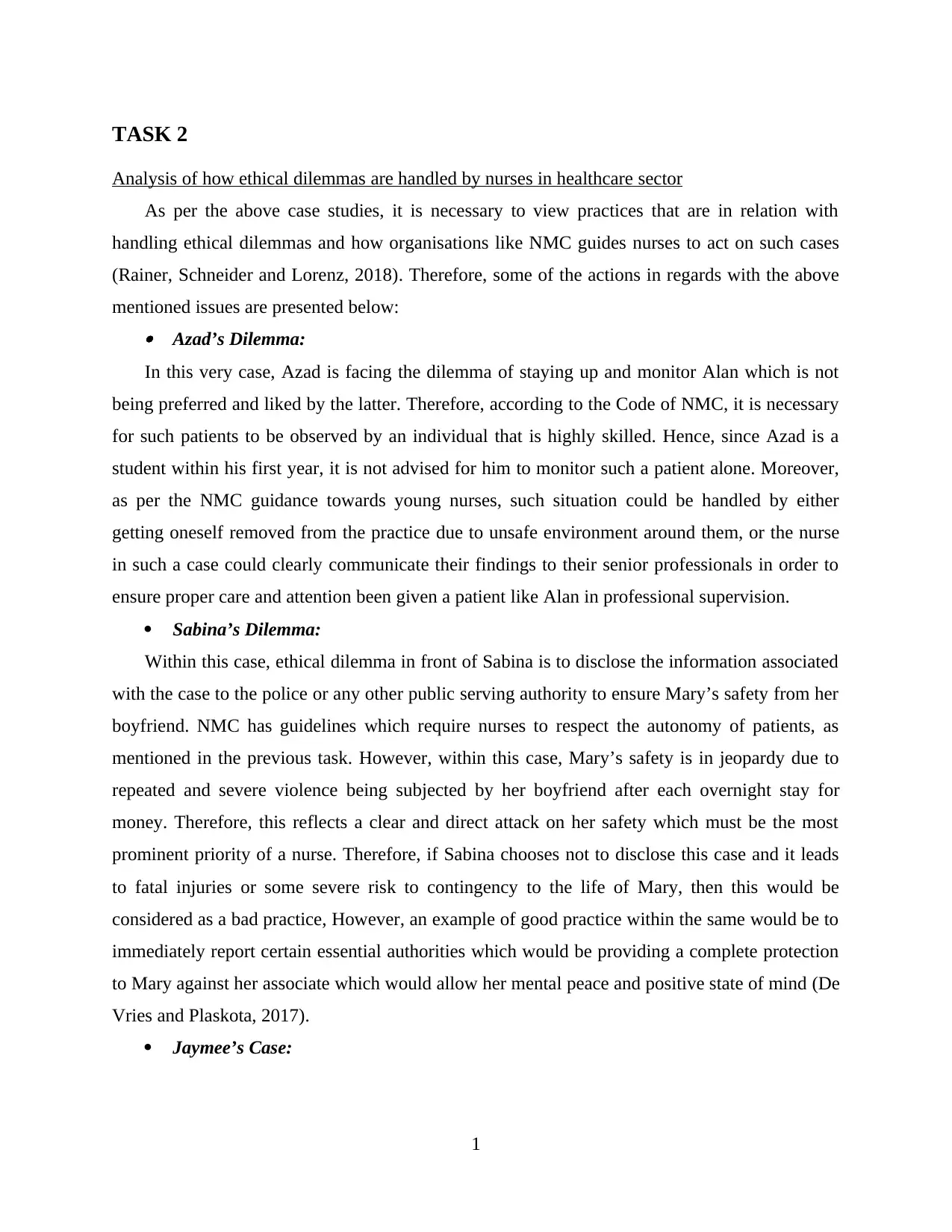
TASK 2
Analysis of how ethical dilemmas are handled by nurses in healthcare sector
As per the above case studies, it is necessary to view practices that are in relation with
handling ethical dilemmas and how organisations like NMC guides nurses to act on such cases
(Rainer, Schneider and Lorenz, 2018). Therefore, some of the actions in regards with the above
mentioned issues are presented below: Azad’s Dilemma:
In this very case, Azad is facing the dilemma of staying up and monitor Alan which is not
being preferred and liked by the latter. Therefore, according to the Code of NMC, it is necessary
for such patients to be observed by an individual that is highly skilled. Hence, since Azad is a
student within his first year, it is not advised for him to monitor such a patient alone. Moreover,
as per the NMC guidance towards young nurses, such situation could be handled by either
getting oneself removed from the practice due to unsafe environment around them, or the nurse
in such a case could clearly communicate their findings to their senior professionals in order to
ensure proper care and attention been given a patient like Alan in professional supervision.
Sabina’s Dilemma:
Within this case, ethical dilemma in front of Sabina is to disclose the information associated
with the case to the police or any other public serving authority to ensure Mary’s safety from her
boyfriend. NMC has guidelines which require nurses to respect the autonomy of patients, as
mentioned in the previous task. However, within this case, Mary’s safety is in jeopardy due to
repeated and severe violence being subjected by her boyfriend after each overnight stay for
money. Therefore, this reflects a clear and direct attack on her safety which must be the most
prominent priority of a nurse. Therefore, if Sabina chooses not to disclose this case and it leads
to fatal injuries or some severe risk to contingency to the life of Mary, then this would be
considered as a bad practice, However, an example of good practice within the same would be to
immediately report certain essential authorities which would be providing a complete protection
to Mary against her associate which would allow her mental peace and positive state of mind (De
Vries and Plaskota, 2017).
Jaymee’s Case:
1
Analysis of how ethical dilemmas are handled by nurses in healthcare sector
As per the above case studies, it is necessary to view practices that are in relation with
handling ethical dilemmas and how organisations like NMC guides nurses to act on such cases
(Rainer, Schneider and Lorenz, 2018). Therefore, some of the actions in regards with the above
mentioned issues are presented below: Azad’s Dilemma:
In this very case, Azad is facing the dilemma of staying up and monitor Alan which is not
being preferred and liked by the latter. Therefore, according to the Code of NMC, it is necessary
for such patients to be observed by an individual that is highly skilled. Hence, since Azad is a
student within his first year, it is not advised for him to monitor such a patient alone. Moreover,
as per the NMC guidance towards young nurses, such situation could be handled by either
getting oneself removed from the practice due to unsafe environment around them, or the nurse
in such a case could clearly communicate their findings to their senior professionals in order to
ensure proper care and attention been given a patient like Alan in professional supervision.
Sabina’s Dilemma:
Within this case, ethical dilemma in front of Sabina is to disclose the information associated
with the case to the police or any other public serving authority to ensure Mary’s safety from her
boyfriend. NMC has guidelines which require nurses to respect the autonomy of patients, as
mentioned in the previous task. However, within this case, Mary’s safety is in jeopardy due to
repeated and severe violence being subjected by her boyfriend after each overnight stay for
money. Therefore, this reflects a clear and direct attack on her safety which must be the most
prominent priority of a nurse. Therefore, if Sabina chooses not to disclose this case and it leads
to fatal injuries or some severe risk to contingency to the life of Mary, then this would be
considered as a bad practice, However, an example of good practice within the same would be to
immediately report certain essential authorities which would be providing a complete protection
to Mary against her associate which would allow her mental peace and positive state of mind (De
Vries and Plaskota, 2017).
Jaymee’s Case:
1
⊘ This is a preview!⊘
Do you want full access?
Subscribe today to unlock all pages.

Trusted by 1+ million students worldwide
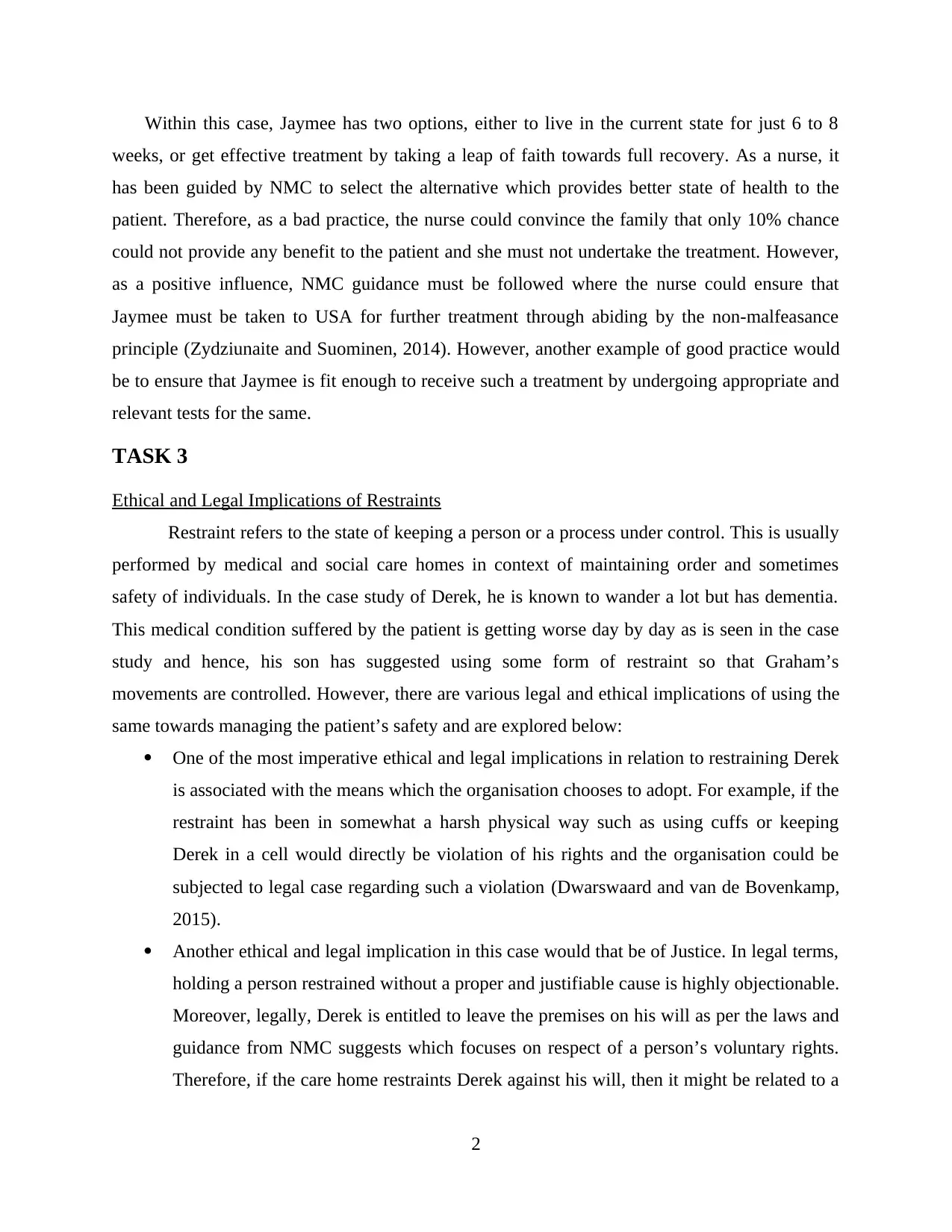
Within this case, Jaymee has two options, either to live in the current state for just 6 to 8
weeks, or get effective treatment by taking a leap of faith towards full recovery. As a nurse, it
has been guided by NMC to select the alternative which provides better state of health to the
patient. Therefore, as a bad practice, the nurse could convince the family that only 10% chance
could not provide any benefit to the patient and she must not undertake the treatment. However,
as a positive influence, NMC guidance must be followed where the nurse could ensure that
Jaymee must be taken to USA for further treatment through abiding by the non-malfeasance
principle (Zydziunaite and Suominen, 2014). However, another example of good practice would
be to ensure that Jaymee is fit enough to receive such a treatment by undergoing appropriate and
relevant tests for the same.
TASK 3
Ethical and Legal Implications of Restraints
Restraint refers to the state of keeping a person or a process under control. This is usually
performed by medical and social care homes in context of maintaining order and sometimes
safety of individuals. In the case study of Derek, he is known to wander a lot but has dementia.
This medical condition suffered by the patient is getting worse day by day as is seen in the case
study and hence, his son has suggested using some form of restraint so that Graham’s
movements are controlled. However, there are various legal and ethical implications of using the
same towards managing the patient’s safety and are explored below:
One of the most imperative ethical and legal implications in relation to restraining Derek
is associated with the means which the organisation chooses to adopt. For example, if the
restraint has been in somewhat a harsh physical way such as using cuffs or keeping
Derek in a cell would directly be violation of his rights and the organisation could be
subjected to legal case regarding such a violation (Dwarswaard and van de Bovenkamp,
2015).
Another ethical and legal implication in this case would that be of Justice. In legal terms,
holding a person restrained without a proper and justifiable cause is highly objectionable.
Moreover, legally, Derek is entitled to leave the premises on his will as per the laws and
guidance from NMC suggests which focuses on respect of a person’s voluntary rights.
Therefore, if the care home restraints Derek against his will, then it might be related to a
2
weeks, or get effective treatment by taking a leap of faith towards full recovery. As a nurse, it
has been guided by NMC to select the alternative which provides better state of health to the
patient. Therefore, as a bad practice, the nurse could convince the family that only 10% chance
could not provide any benefit to the patient and she must not undertake the treatment. However,
as a positive influence, NMC guidance must be followed where the nurse could ensure that
Jaymee must be taken to USA for further treatment through abiding by the non-malfeasance
principle (Zydziunaite and Suominen, 2014). However, another example of good practice would
be to ensure that Jaymee is fit enough to receive such a treatment by undergoing appropriate and
relevant tests for the same.
TASK 3
Ethical and Legal Implications of Restraints
Restraint refers to the state of keeping a person or a process under control. This is usually
performed by medical and social care homes in context of maintaining order and sometimes
safety of individuals. In the case study of Derek, he is known to wander a lot but has dementia.
This medical condition suffered by the patient is getting worse day by day as is seen in the case
study and hence, his son has suggested using some form of restraint so that Graham’s
movements are controlled. However, there are various legal and ethical implications of using the
same towards managing the patient’s safety and are explored below:
One of the most imperative ethical and legal implications in relation to restraining Derek
is associated with the means which the organisation chooses to adopt. For example, if the
restraint has been in somewhat a harsh physical way such as using cuffs or keeping
Derek in a cell would directly be violation of his rights and the organisation could be
subjected to legal case regarding such a violation (Dwarswaard and van de Bovenkamp,
2015).
Another ethical and legal implication in this case would that be of Justice. In legal terms,
holding a person restrained without a proper and justifiable cause is highly objectionable.
Moreover, legally, Derek is entitled to leave the premises on his will as per the laws and
guidance from NMC suggests which focuses on respect of a person’s voluntary rights.
Therefore, if the care home restraints Derek against his will, then it might be related to a
2
Paraphrase This Document
Need a fresh take? Get an instant paraphrase of this document with our AI Paraphraser
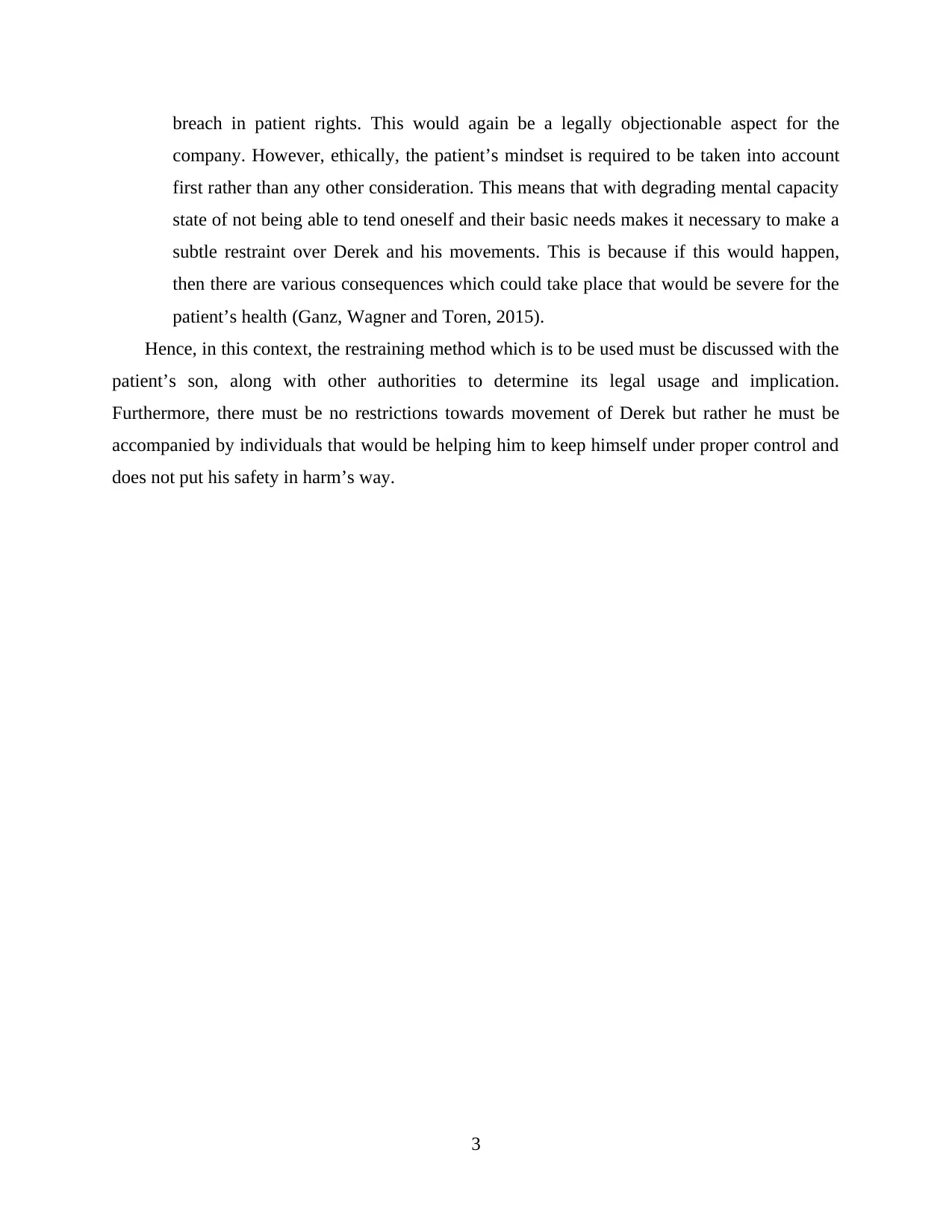
breach in patient rights. This would again be a legally objectionable aspect for the
company. However, ethically, the patient’s mindset is required to be taken into account
first rather than any other consideration. This means that with degrading mental capacity
state of not being able to tend oneself and their basic needs makes it necessary to make a
subtle restraint over Derek and his movements. This is because if this would happen,
then there are various consequences which could take place that would be severe for the
patient’s health (Ganz, Wagner and Toren, 2015).
Hence, in this context, the restraining method which is to be used must be discussed with the
patient’s son, along with other authorities to determine its legal usage and implication.
Furthermore, there must be no restrictions towards movement of Derek but rather he must be
accompanied by individuals that would be helping him to keep himself under proper control and
does not put his safety in harm’s way.
3
company. However, ethically, the patient’s mindset is required to be taken into account
first rather than any other consideration. This means that with degrading mental capacity
state of not being able to tend oneself and their basic needs makes it necessary to make a
subtle restraint over Derek and his movements. This is because if this would happen,
then there are various consequences which could take place that would be severe for the
patient’s health (Ganz, Wagner and Toren, 2015).
Hence, in this context, the restraining method which is to be used must be discussed with the
patient’s son, along with other authorities to determine its legal usage and implication.
Furthermore, there must be no restrictions towards movement of Derek but rather he must be
accompanied by individuals that would be helping him to keep himself under proper control and
does not put his safety in harm’s way.
3
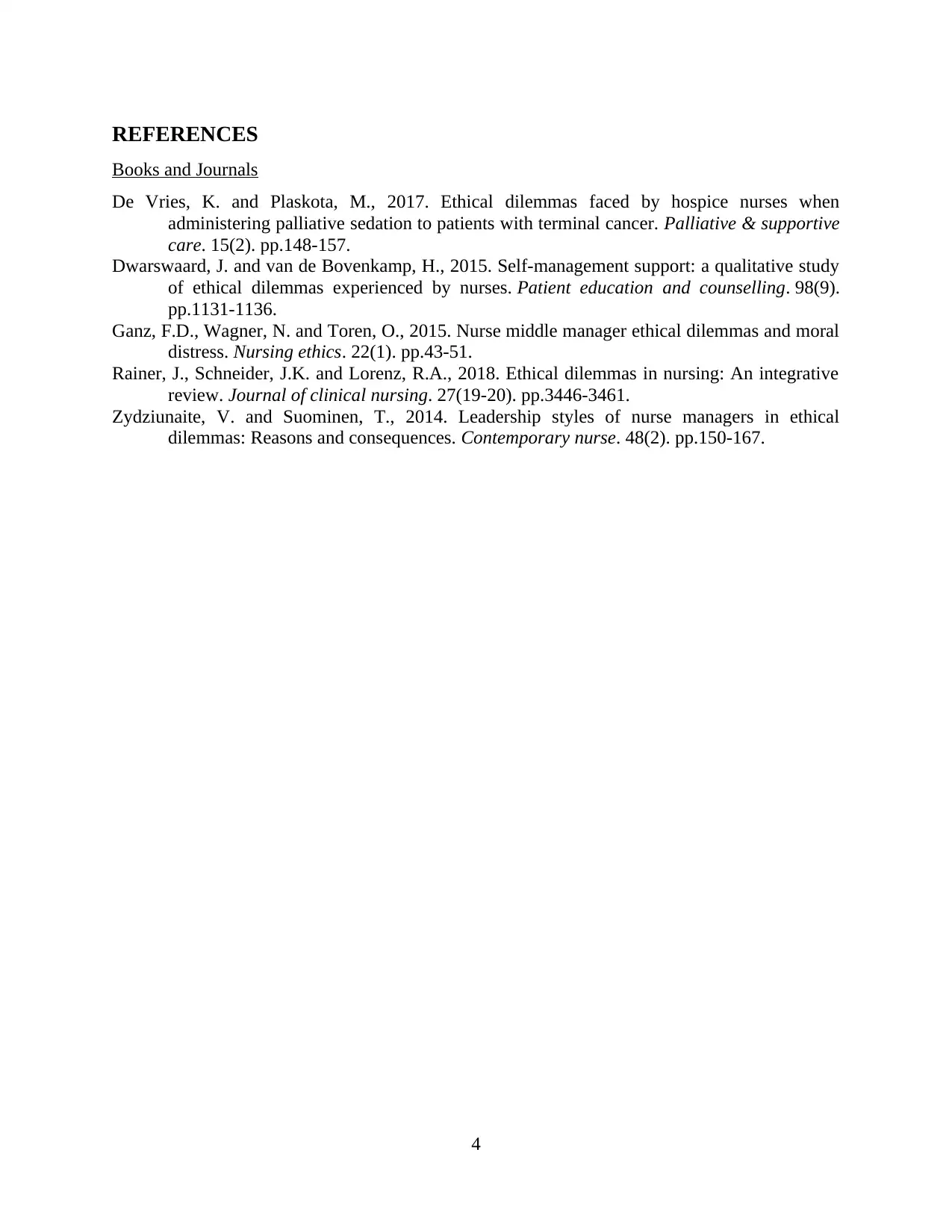
REFERENCES
Books and Journals
De Vries, K. and Plaskota, M., 2017. Ethical dilemmas faced by hospice nurses when
administering palliative sedation to patients with terminal cancer. Palliative & supportive
care. 15(2). pp.148-157.
Dwarswaard, J. and van de Bovenkamp, H., 2015. Self-management support: a qualitative study
of ethical dilemmas experienced by nurses. Patient education and counselling. 98(9).
pp.1131-1136.
Ganz, F.D., Wagner, N. and Toren, O., 2015. Nurse middle manager ethical dilemmas and moral
distress. Nursing ethics. 22(1). pp.43-51.
Rainer, J., Schneider, J.K. and Lorenz, R.A., 2018. Ethical dilemmas in nursing: An integrative
review. Journal of clinical nursing. 27(19-20). pp.3446-3461.
Zydziunaite, V. and Suominen, T., 2014. Leadership styles of nurse managers in ethical
dilemmas: Reasons and consequences. Contemporary nurse. 48(2). pp.150-167.
4
Books and Journals
De Vries, K. and Plaskota, M., 2017. Ethical dilemmas faced by hospice nurses when
administering palliative sedation to patients with terminal cancer. Palliative & supportive
care. 15(2). pp.148-157.
Dwarswaard, J. and van de Bovenkamp, H., 2015. Self-management support: a qualitative study
of ethical dilemmas experienced by nurses. Patient education and counselling. 98(9).
pp.1131-1136.
Ganz, F.D., Wagner, N. and Toren, O., 2015. Nurse middle manager ethical dilemmas and moral
distress. Nursing ethics. 22(1). pp.43-51.
Rainer, J., Schneider, J.K. and Lorenz, R.A., 2018. Ethical dilemmas in nursing: An integrative
review. Journal of clinical nursing. 27(19-20). pp.3446-3461.
Zydziunaite, V. and Suominen, T., 2014. Leadership styles of nurse managers in ethical
dilemmas: Reasons and consequences. Contemporary nurse. 48(2). pp.150-167.
4
⊘ This is a preview!⊘
Do you want full access?
Subscribe today to unlock all pages.

Trusted by 1+ million students worldwide
1 out of 6
Related Documents
Your All-in-One AI-Powered Toolkit for Academic Success.
+13062052269
info@desklib.com
Available 24*7 on WhatsApp / Email
![[object Object]](/_next/static/media/star-bottom.7253800d.svg)
Unlock your academic potential
Copyright © 2020–2025 A2Z Services. All Rights Reserved. Developed and managed by ZUCOL.





